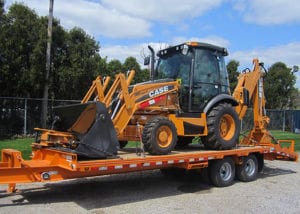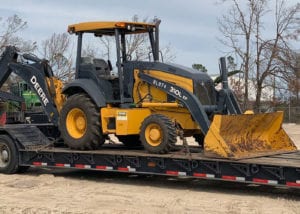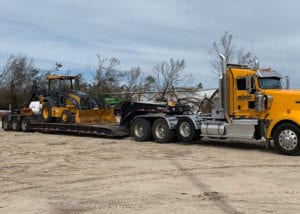BACKHOE TRANSPORT SERVICES
We provide power only, project freight, oversize, and specialized heavy haul trucking for clients of all sizes.
How do you execute a backhoe transport?
If you have just recently purchased a backhoe loader, or just need to move it from one location to another, the question is always “how do I transport a backhoe?” Typically, backhoe transport companies will suggest evaluating the transport dimensions of the piece of equipment needing to be hauled. Shipping backhoe loaders are a bit tricky because on all of the websites you find, the backhoe transport dimensions say that the overall height of the unit is 12 feet tall. This height, if followed by, would then require you to put this equipment on a lowboy due to restrictions. The way around this inflated cost would be to lower the arm so that the overall height now does not exceed 10 feet. You can now put the backhoe on a step deck, potentially hauling with another piece of freight to reduce your overall shipment cost.
How do you safely ship a backhoe loader?
As long as the equipment isn’t over height, your backhoe can ship on a standard dock height flatbed trailer, which of course you will need a dock in which to load from.
Larger backhoe loaders are shipped on step deck or removable gooseneck trailers. Either option will allow you to drive the backhoe loader up on the trailer from the ground. If you’re want to load from the front of the trailer, make sure to back the backhoe loader onto the trailer. When loading onto a flatbed trailer, just drive her right on.
Other Logistics Services: Driveaway | Intermodal| Trade Show | Dry Van | Refrigerated
The Tractor
The core structure of a backhoe loader is the tractor. Just like the tractors that farmers use in their fields, the backhoe tractor is designed to move easily over all kinds of rough terrain.
It has a powerful, turbocharged diesel engine, large, rugged tires and a cab with basic steering controls (a steering wheel, brakes, etc.). Backhoe cabs are either completely enclosed or have an open canopy structure to give the operator protection.
The Loader
The loader is attached in the front and the backhoe is attached in the back. These two components serve very different functions.
The loader can do several different things. In many applications, you use it like a big, powerful dustpan or coffee scoop. You usually don’t dig with it; you mostly use it to pick up and carry large amounts of loose material. It’s also used to smooth things over like a butter knife, or to push dirt like a plow. The operator controls the loader while driving the tractor.
The Backhoe
The backhoe is the main tool of the backhoe loader. It’s used to dig up hard, compact material, usually earth, or to lift heavy loads, such as a sewer box. It can lift this material and drop it in a pile to the side of the hole.
Basically, the backhoe is a big, extremely powerful version of your arm or finger. It has three segments:
- The boom
- The stick
- The bucket
This arrangement is very similar to your arm. Your arm has three segments — your upper arm, forearm and hand.
The backhoe segments are connected by three joints, comparable to your wrist, elbow and shoulder. The backhoe moves in pretty much the same way as your arm. In a Caterpillar® backhoe, the boom is bent upward to make it easier to dig with obstacles in the way. This design also provides extra space for the bucket when the operator curls it in with a full load.
The backhoe can dig all sorts of holes, but is especially suited for digging ditches. To use the backhoe, the operator has to park the tractor and turn the seat around.
So what do the tractor, loader and backhoe have to do with each other? The tractor component is for moving the other two components from place to place, and the operator also maneuvers it when using the loader. The loader and backhoe components are a natural combination for all sorts of jobs. When you dig up a lot of dirt to make a ditch or any other sort of hole, you generally need a loader to either move the dirt out of the area or to fill the dirt back in once you’ve got the pipes, power lines, etc. in position. The most common application for a backhoe loader is this basic job — digging a trench with the backhoe and then back-filling it with the loader.
The Stabilizer Legs
The other appendages you’ll typically notice on a backhoe loader are the two stabilizer legs just behind the rear wheels. These legs are crucial to backhoe operation because they take the brunt of the weight when a backhoe is digging. Without the stabilizer legs, the weight of a heavy load or the downward force of digging into the ground would strain the wheels and tires, and the whole tractor would bounce constantly.
The stabilizers keep the tractor steady, minimizing the jostling effect of digging with the backhoe. They also secure the tractor so that it won’t slip into the ditch or hole.
The stabilizer legs have two types of “shoes,” so that they can be planted securely on both dirt and pavement. The grouser shoe side digs into the dirt for a better grip, but would tear up the pavement if you were to use it on a road. For a good grip on asphalt, the operator simply flips the rubber-padded shoe into position.
What is a backhoe?
A backhoe — also called rear actor or back actor — is a type of excavating equipment, or digger, consisting of a digging bucket on the end of a two-part articulated arm. It is typically mounted on the back of a tractor or front loader, the latter forming a “backhoe loader” (colloquially known as a “JCB” in Ireland and the UK). The section of the arm closest to the vehicle is known as the boom, while the section that carries the bucket is known as the dipper (or dipper-stick), both terms derived from steam shovels. The boom is generally attached to the vehicle through a pivot known as the king-post, which allows the arm to pivot left and right, usually through a total of 180 to 200 degrees.
A backhoe loader is an interesting invention because it is actually three pieces of construction equipment combined into one unit. A backhoe loader is:
- A tractor
- A loader
- A backhoe



Titan provides solutions customized to meet your needs
Understanding your requirements and objectives is important to us. We listen and work together to create a truly successful supply chain.
Request a backhoe transport quote
Characteristics of a backhoe loader
- It consists of an assembly of three different pieces of mobile earth moving equipment: a tractor, a loader and a backhoe.
- It allows the tools to move quickly and safely.
- It can transport large quantities of material depending on the size of the container.
- It is mainly designed for excavating land.
- The container where the material is deposited is known as a bucket.
- The backhoe itself has three parts: the bucket, the stick and the boom.
- It is also known as a mechanical shovel.
Types of backhoes to transport
Bucket excavators are also known as excavator shovels or mechanical shovels. They are used for vertical type excavations, well production and mining. They can be assembled on tires or on crawlers and have the ability to rotate on themselves with the help of an axis of up to 360 degrees.
Another type of backhoe loaders are hydraulic excavators. Their price is more affordable, and their power is the same. Unlike mechanical shovels, they work on the ground from top to bottom and are quicker to load material. The pushing shovel has the bucket upwards and can unload from a higher height. It is mainly used in mining.
Common backhoes transported
Caterpillar – an American company that designs, markets and sells machinery and engines. It is known as the world’s leading manufacturer of construction machinery. Marketed under the CAT brand, Caterpillar manufactures the most reliable backhoe loaders with superior digging and excavation capabilities, demolition and excavation, landscaping and asphalt. Small CAT backhoes are useful for operating in areas where it is not possible to use larger machines.
Volvo – these backhoe loaders are everything you’ve ever wanted in a machine. It has a backhoe with the strength of a Volvo wheel loader and the performance of a Volvo excavator. It has an operator station that will keep you in extreme comfort. With features such as the reliable Volvo engine and electrohydraulic transmission, the machine guarantees long and productive life. The best thing about Volvo is that its machines are 95% recyclable, which helps to preserve the environment. These are the stars of the world of backhoes.
JCB Limited – a leading manufacturer of construction equipment in the world. It has world-class facilities. It produces backhoes of various configurations and sizes. Its model with only 1.4 meters wide, has the ability to rotate on its own axis due to its Skid Steer design. JCB has been manufacturing backhoes according to the conditions, and needs of the land, which has helped them grow faster. Many companies offer JCB backhoe for rent.
Komatsu – a subsidiary of Komatsu Ltd., a manufacturer of construction, mining, and industrial machinery. Manufactures backhoes that are effective and provides a catalog for each product. Its products are known for their power, with the WA 900-3EO exceeding the power of 2000 rpm. Some of the backhoes also have a wireless tracking system that helps increase the productivity of the machine.
Mahindra – The new entrant in the Mahindra Earth Master market is loaded with extraordinary features. It is the new generation of backhoes in India backed by Mahindra’s engineering capabilities, manufacturing strength, and after-sales service.
The backhoe is built keeping in mind the rough Indian terrain and the latest vehicle systems, so it can work anywhere, even on rough and difficult terrain. In addition, their backhoes have some new additions to their list of features that offer greater reliability, less maintenance, and exceptional fuel efficiency. They are available at a price well within the reach of simple businesses.
Licensed, Bonded and Insured
Titan Worldwide is a fully licensed, bonded and insured heavy equipment transport firm that operates in all 48 contiguous US states, Canada and Mexico.
Headquartered in Dallas, Texas, Titan Worldwide provides innovative logistics and heavy haul trucking solutions to corporations nationwide. Our services require us to operate within the guidelines of the United States Department of Transportation and retain the proper licensing to haul contract cargo along intrastate and interstate lines. As a company, Titan Worldwide operates with a Motor Carrier License number of 122020 and a DOT license number of 3174800. Not only do we require our drivers to carry enough cargo insurance to full cover the value of your cargo, we too carry a contingent cargo policy to layer up on the coverage.



